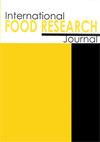Emerging natural and high-phenolic sweet substances: A review
IF 1
4区 农林科学
Q4 FOOD SCIENCE & TECHNOLOGY
引用次数: 0
Abstract
Emerging high-phenolic sweeteners impart a sweet taste to foods and beverages, and are desirable sugar alternatives. Most refined sugars have a low antioxidant content due to polyphenol degradation occurring during sugar refining. Natural sweeteners such as honey, molasses, and dark brown sugar possess moderate to high phenolic content. Other phytochemicals found in natural sweeteners are carotenoids, organic acids, and terpenoids. Additionally, molasses and syrups synthesised from anthocyanin-rich fruits and roots contain anthocyanins apart from flavonoids. Non-nutritive sweeteners, such as sugar alcohols, are low in calories besides their sweet taste. Sweet proteins, dihydrochalcones, phenolics, and terpenoid derivatives are emerging sweeteners. These sweet substances are effective antioxidants that could help reduce oxidative stress in the human body although the amount ingested is usually low. The present review emphasised specific natural, high-phenolic, and other sweet compounds, and examined the antioxidative characteristics of these sweeteners. The risk of excessive ingestion of these sweet substances is yet to be proven.新兴的天然高酚类甜物质综述
新兴的高酚类甜味剂赋予食品和饮料甜味,是理想的糖替代品。大多数精制糖的抗氧化剂含量较低,因为在糖精制过程中会发生多酚降解。天然甜味剂如蜂蜜、糖蜜和红糖具有中等至高的酚含量。在天然甜味剂中发现的其他植物化学物质有类胡萝卜素、有机酸和萜类。此外,由富含花青素的水果和树根合成的糖蜜和糖浆除了含有类黄酮外,还含有花青素。非营养性甜味剂,如糖醇,除了甜味外,卡路里含量很低。甜蛋白、二氢查尔酮、酚类和萜类衍生物是新兴的甜味剂。这些甜的物质是有效的抗氧化剂,可以帮助减少人体的氧化应激,尽管摄入量通常很低。本综述强调了特定的天然、高酚类和其他甜化合物,并研究了这些甜味剂的抗氧化特性。过量摄入这些甜物质的风险还有待证实。
本文章由计算机程序翻译,如有差异,请以英文原文为准。
求助全文
约1分钟内获得全文
求助全文
来源期刊

international food research journal
Agricultural and Biological Sciences-Food Science
CiteScore
1.40
自引率
0.00%
发文量
75
期刊介绍:
The International Food Research Journal (IFRJ) publishes papers in English, six (6) issues a year with the coverage of:
Food Science and Technology
Nutrition and Dietetics
Agriculture, multidisciplinary
Chemistry, multidisciplinary
The scope of the Journal includes:
Food Science, Food Technology and Food Biotechnology
Product Development and Sensory Evaluation
Food Habits, Nutrition, and Health
Food Safety and Quality
Food Chemistry, Food Microbiology, Food Analysis and Testing
Food Engineering
Food Packaging
Food Waste Management
Food Entrepreneur
Food Regulatory
Post-Harvest Food Management
Food Supply Chain Management
Halal Food and Management
 求助内容:
求助内容: 应助结果提醒方式:
应助结果提醒方式:


